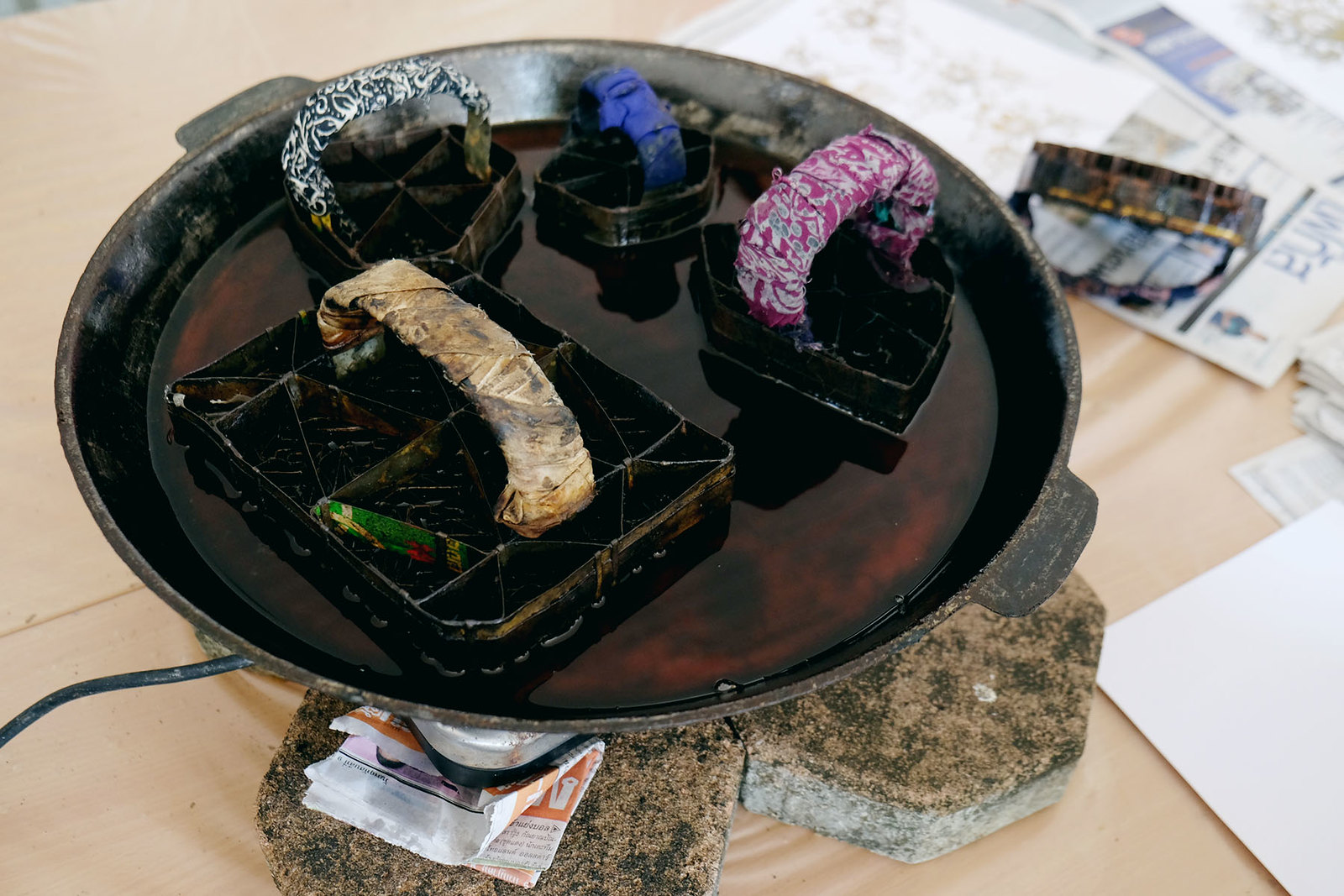Recently, I had a chance to learn the craft of ancient Southern batik at the workshop arranged by SACICT ( The Support Arts and Crafts International Centre of Thailand) at the center in Bang Sai, Ayudhaya. One of the instructor was Thanintorn Raksawong, 2010 Asean awarded artist who has created a beautiful collection of handmade batik that reflects the unique identity and wisdom of her Southern hometown. Thanintorn , or kru Oh, showed us the tools and demonstrated the process of ancient batik textiles. To make a truly authentic Batik, you need melted beeswax, special steel pan and special tools which are ancient metal blocks.
Kru Oh told us the stories about Melayu ethnic textiles, which were seen across Java island, Indonesia, and Malaysia. Before, there were no countries but Melayu so the textile culture was naturally flowing from one place to another, resulting in similar designs and aesthetics.
Not only people of the ancient time, the textiles, as well had been classified into different castes. If the textiles were done by the delicate, very detailed metal blocks made from gold or copper, then they were specially for the king or the monarchies. Those metal blocks, which were later mocked into wood blocks by ordinary people, were very precise and give meticulous details.



These blocks were handmade by the ancient technique, carefully and meticulously done by only specifically trained goldsmith. Long metal sheets were folded, curved, cut and filled until they get to the thickness of the line. The blocks like these are now very rare, and could cost over 5,000 THB per piece.
Nowadays, we could only see these ancient metal blocks in only some provinces in Southern Thailand including the three southern border provinces of Thailand. Kru Oh used to live and work in Narathiwat until the situation only got worse and worse, then she moved to Krabi. She learned this wisdom and practice techniques from her grandmother.


The beeswax recipe
The heart of the ancient southern handmade batik lies in the blocks and the wax melting process. It is often misunderstood that batik fabrics made with tjantings and brushes these days were authentic. And I just knew this too, when Kru Oh explained that the real batik technique must be done by these metal blocks. Only when the blocks were destroyed during the war and rapid country development, that people started to use the tjanting instead.
The melted beeswax is done by melting paraffin, beeswax, and rosin together. Another essential tool to create a perfect wax stamping is a thick, high-quality steel pan. It was crafted by the smith and designed specially for the fabric printing process. This pan is the key, because when you’re capable of controlling the heat, your work is half done.




Trying with the Indian Wood blocks
I also tried wax stamping with my collected indian wood blocks, the result was obviously much worse than metal blocks. As you see, the quality is very different comparing to the ones above. It is nice to try this methods on different surfaces, too.
After wax stamping is done, the fabrics would be taken to piece-dye or paint with dyes. Here in this workshop SACICT’s team, Pa Jiw from Mae Teeta, mother of Sakon Nakhon’s natural indigo dye, has joined Kru Oh and gave permission for everyone to use or indigo pot. It was a great feeling to see your resisted wax clearer and clearer when the piece turned blue.










งานผ้าบาติกโบราณ – ดาหลาบาติก
ผ้าบาติกโบราณเป็นงานฝีมือที่เราสนใจมาได้สักพักใหญ่ แต่ไม่เคยได้ลองทำ จนเมื่อ SACICT หรือศูนย์ศิลปาชีพระหว่างประเทศ ได้จัดเวิร์คช็อปกับครูช่างธนินท์ธร หรือครูโอ๋ ผู้เชี่ยวชาญเรื่องงานผ้าบาติกโบราณจากดาหลาบาติก จ.กระบี่ ก็เลยได้ไปทดลองทำและเรียนรู้ ครูโอ๋สืบทอดภูมิปัญญานี้มาจากคุณยายซึ่งเป็นช่างบาติกเก่าแก่ตั้งแต่สมัยผ้าปาเต๊ะยังรุ่งเรือง โดยเมื่อก่อนความสมบูรณ์ของมลายู คือแบบเดียวกับของบาหลีในวันนี้ ยังไม่มีการแบ่งพื้นที่ประเทศเป็นไทย มาเลย์ อินโด ดังนั้นผ้าทางชวา อินโดนีเซีย มาเลเซีย จึงเป็นผ้าที่มีวัฒนธรรมเลื่อนไหลไปมาหากันและมีความคล้ายคลึงกัน และก็เช่นกันกับคน ผ้าจะมีวรรณะต่างๆ หากมีรายละเอียดมาก เกิดจากการใช้โลหะเช่นแท่งทอง ทองแดง มาทำเป็นแม่พิมพ์ ก็จะเป็นผ้าสำหรับวรรณะกษัตริย์ หลังจากนั้นพอชาวบ้านมาเห็นเข้าก็ดัดแปลง นำไปทำลงบนไม้เกิดเป็นบล็อกไม้ (woodblock) ขึ้นมา
ในสมัยก่อนผ้าปาเต๊ะ หรือบาติก เป็นผ้าพื้นเมืองทางใต้-มลายู ที่ชาวบ้านนิยมทำและนุ่งใส่กันมาก จนมาในสมัยจอมพล ป. พิบูลสงครามปฏิรูปประเทศไทยให้นำสมัย จึงมีคำสั่งห้ามเคี้ยวหมาก ทำผ้าหรือใส่ผ้าพื้นเมือง ไปจนกระทั่งทัดดอกไม้ ครูโอ๋เล่าว่าในยุคนั้นหากใครทำผ้า บล็อกแม่พิมพ์จะถูกนำไปทำลายทิ้งหมด ดังนั้นคุณยายของครูโอ๋จึงหลบหนีไปอยู่ทางฝั่งมาเลเซีย ต่อมาได้เป็นนักเรียนที่เมืองปีนัง จึงทำผ้าส่งไปปีนังและยังคงมีชื่อเสียงอยู่ทุกวันนี้
กรรมวิธีการทำผ้าบาติกโบราณนั้น หัวใจจะอยู่ที่แม่พิมพ์และการทำน้ำเทียน สิ่งที่เรามักเข้าใจผิดบ่อยๆคือ บาติกที่ใช้จันติ้งและพู่กันเขียน ที่เราเห็นในทุกวันนี้นั้นไม่ใช่บาติกแบบดั้งเดิม เพราะของแท้ดั้งเดิมนั้นคือการใช้บล็อกแม่พิมพ์โลหะที่ทำจากทองหรือทองแดงปั๊มเทียนลงไป แต่เมื่อแม่พิมพ์ถูกทำลายและหายไป คนจึงหันมาประยุกต์โดยใช้จันติ้งเขียนลวดลายแทนการปั๊มเทียน ปัจจุบันแม่พิมพ์โลหะโบราณนั้นจึงหาได้ยากและมีราคาแพงมาก ชิ้นหนึ่งเริ่มต้นที่ 5,000 บาท แต่ก็ยังมีคนทำอยู่บ้างใน 3 จังหวัดชายแดนภาคใต้ของไทย
ส่วนน้ำเทียน เกิดจากการหลอมพาราฟิน ขี้ผึ้ง และยางสน ซึ่งยางสนถ้าแช่ในน้ำจะเป็นตัวยึดความแข็งแรงของเทียน อุปกรณ์สำคัญอีกอย่างที่ขาดไม่ได้คือกระทะเหล็กแท้สำหรับพิมพ์ผ้าโดยเฉพาะ ซึ่งครูโอ๋ได้รับตกทอดเป็นมรดกมาจากคุณยาย กระทะนี้ทำมาจากเหล็กกล้าและมีความหนา เป็นเครื่องมือสำคัญในการควบคุมความร้อน เพราะการทำบาติกโบราณ หากเราคุมความร้อนได้นั้นหมายความว่ามีชัยไปกว่าครึ่งนั่นเอง
ด้วยความตั้งใจที่จะสืบทอดงานผ้าโบราณไม่ให้สูญหายไป ครูโอ๋จึงเริ่มเปิดให้ผู้ที่สนใจเข้าชมและเรียนรู้กรรมวิธีการทำบาติกแบบดั้งเดิมนี้ นี่เป็นเพียงช้อทโน้ตแบบย่อๆที่เราจับใจความมาจากการบรรยาย หากใครสนใจจะเรียนรู้แบบลงลึก ก็สามารถติดต่อไปศึกษาดูงานกับครูโอ๋ที่ดาหลาบาติก จังหวัดกระบี่ได้ตามที่อยู่ด้านล่างนี้เลยค่ะ
For More information : Dala Batik Group
19 Bangnak Subdistrict, Muang District, Narathiwas 96000
Contact : Thaninthon Raksawong
08 1479 5060, 08 1540 0478
dahlabatik@hotmail.com
Thank you Metavee Varintaravejh for letting me use some of your photographs from the workshop. Please check out her sublime world of crafts and ceramics here
All images copyright © Kamonnart Ongwandee & Metavee Varintaravejh




